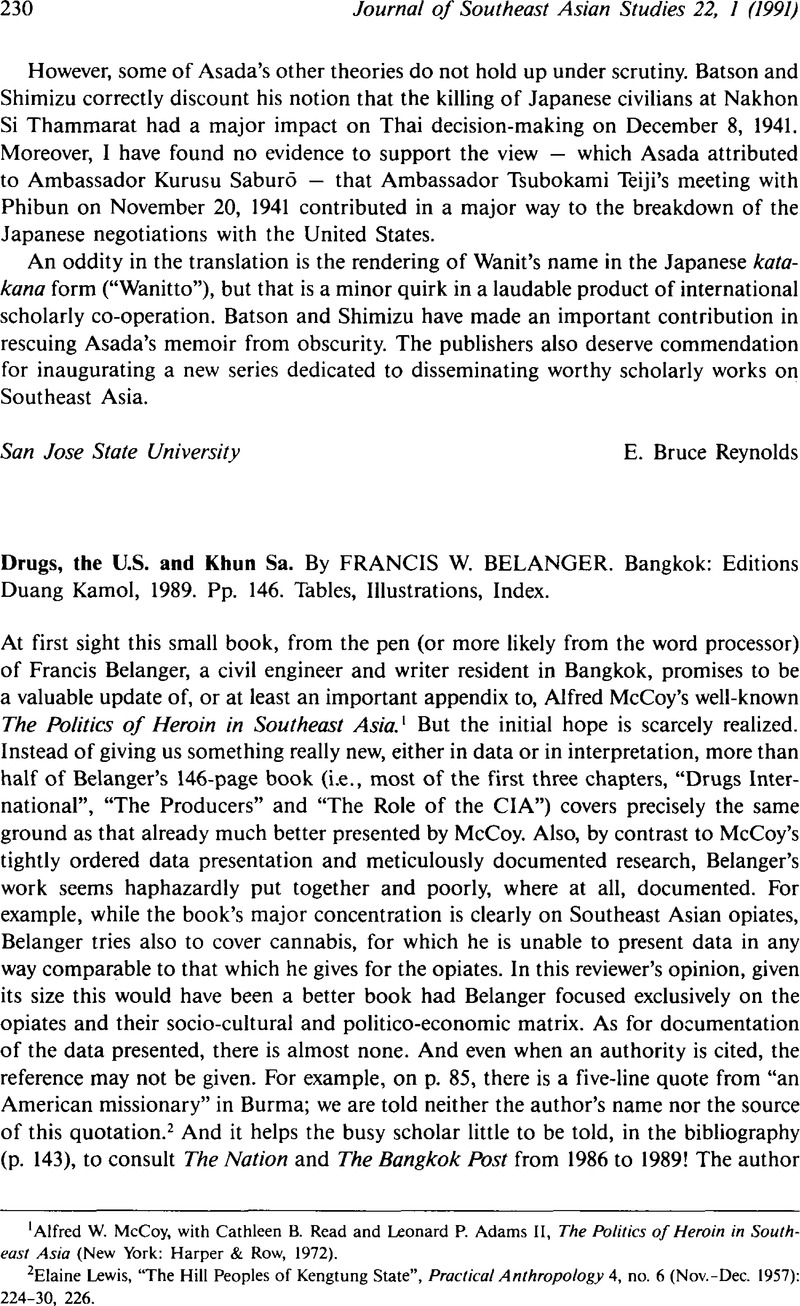No CrossRef data available.
Published online by Cambridge University Press: 24 August 2009

1 Alfred W. McCoy, with Cathleen B. Read and Leonard P. Adams II, The Politics of Heroin in Southeast Asia (New York: Harper & Row, 1972)Google Scholar.
2 Lewis, Elaine, “The Hill Peoples of Kengtung State”, Practical Anthropology 4, no. 6 (11–12 1957): 224–30, 226Google Scholar.
3 E.g. (in chronological order), Weintraub, Peter and Lawton, David, “Thailand's Drug Trade Tangle”, Far Eastern Economic Review (28 04 1978): 23–27Google Scholar; Liu, Melinda, “The Triangle's Pecking Order”, Far Eastern Economic Review (24 09 1979): 38–40Google Scholar; Tun, M.C., “Letter from the Golden Triangle”, Far Eastern Economic Review (4 04 1979)Google Scholar; Pringle, James, “Inside the ‘Golden Triangle’”, Newsweek (9 02 1981): 11Google Scholar; “Cockpit of Anarchy”, Asiaweek (29 05 1981): 28–34Google Scholar; Hail, John, “Long and Hazardous Hunt for the Opium Warlord”, Bangkok Post (11 01 1982): 9Google Scholar; Sumondis, Pummarie et al. , “The Battle Against the Opium Warlord”, Bangkok Post (31 01 1982): 20Google Scholar; “Warlord on the Run”, Asiaweek (19 02 1982): 22–31Google Scholar; Paul, Anthony, “Thais Run Thailand”, Asiaweek (19 02 1982): 32–33Google Scholar; Linter, Bertil, “New Year New Fears”, Business in Thailand 14, no. 2 (02 1983): 175–81Google Scholar; “A Tidal Wave of Heroin”, Asiaweek (5 08 1983): 20–25, 28Google Scholar; “The Opium Trade in Southeast Asia”, The Nation (5 02 1984): 15, 20Google Scholar; Shannon, Elaine, “The Asian Connection”, Newsweek (25 06 1984): 24–25Google Scholar; White, Terence, “Politics in the Poppy Fields”, Asia Magazine (24 01 1985): 5–8, 11Google Scholar; Smith, Martin, “Politics of Opium: Burma's Shan Rebel Groups”, Inside Asia (09–10 1985): 7–9Google Scholar; Gooi, Kim, “Getting Behind the Legend of Khun Sa, the Opium King”, New Straits Times (27 01): 11, (28 01): 8, (29 01): 6, (30 01): 11 and (31 01 1986): 10Google Scholar; Gooi, Kim and McBeth, John, “High-priced High”, Far Eastern Economic Review (20 02 1986): 28–29Google Scholar; Gooi, Kim, “Just a Freedom Fighter: Interview/Khun Sa”, Far Eastern Economic Review (20 02 1986): 28–29Google Scholar; Saul, John Ralston, “The Route of Evil”, Asia Magazine (5 10 1986): 9–10, 13–14, 16–17Google Scholar; White, Terrence, “The Private World of Khun Sa”, Asia Magazine (12 07 1987): 10–16Google Scholar; Manibhandu, Anuraj, “Abbot Calls for Talks with Khun Sa”, Bangkok Post (27 02 1988): 5Google Scholar; Drummond, Andrew, “Ruler of the Opium Empire”, Observer Magazine (16 07 1989): 28–32Google Scholar; “Losing the Poppy War”, Asiaweek (28 07 1989): 31Google Scholar; Gray, Denis D., “A Deluge from Golden Triangle”, The Nation (2 02 1989): 9Google Scholar; Bishop, Charles, “The Ultimate Merchandise”, Bangkok Post (18 02 1990): 27, 36Google Scholar; Linter, Bertil, “The Phoney Way”, “A Fix in the Making”, “Head on a Plate”, and “Roads from Mandalay”, Far Eastern Economic Review (28 06 1990): 20–27Google Scholar; Lertcharoenchok, Yindee, “Khun Sa, Anti-Govt Shans Strike Alliance”, The Nation (15 06 1990): 5Google Scholar and “A Glimpse into the Land of Tai”, The Nation (29 07 1990): 11, 18Google Scholar. There are, of course, many many more.
4 E.g. Cooper, Robert, Resource Scarcity and the Hmong Response (Singapore: Singapore University Press, 1985)Google Scholar; Dessaint, Alain Y., “The Poppies are Beautiful This Year”, Natural History 81, no. 2 (02 1972): 31–36Google Scholar; Geddes, William Robert, Migrants of the Mountains (Oxford: The Clarendon Press, 1976)Google Scholar; Keen, F.G.B., Upland Tenure and Land Use in North Thailand (Bangkok: SEATO, 1973)Google Scholar; Suwanwela, Charas et al. , Health Status in Meo Village, Ban Meo Khun Wang (Bangkok: Inst. of Health Research, Chulalongkorn University, 1977)Google Scholar, The Hill Tribes of Thailand: Their Opium Use and Addiction (Bangkok: Inst. of Health Research, Chulalongkorn University, 1977)Google Scholar, Hill Tribe Opium Addicts: A Retrospective Study of 1382 Patients (Bangkok: Inst. of Health Research, Chulalongkorn University, 1978)Google Scholar, Socio-economic Realities and their Implications in the Treatment of Drug Dependent Persons (Bangkok: Inst. of Health Research, Chulalongkorn University, 1978)Google Scholar, Overview of Drug Dependence Treatment in Thailand (Bangkok: Inst. of Health Research, Chulalongkorn University, 1978)Google Scholar, Primary Health Care in the Hill Tribe Villages (Bangkok: Inst. of Health Research, Chulalongkorn University, 1978)Google Scholar; Tapp, Nicholas, The Hmong of Thailand: Opium People of the Golden Triangle (London: Anti-Slavery Society, 1986)Google Scholar, and Sovereignty and Rebellion: The White Hmong of Northern Thailand (Singapore: Oxford University Press, 1989)Google Scholar; Walker, Anthony R., “The Production and Use of Opium in the Northern Thai Uplands: An Introduction”, Contemporary Southeast Asia 2, no. 2 (1980): 135–54CrossRefGoogle Scholar, and “Opium: Its Cultivation and Use in a Lahu Nyi (Red Lahu) Village Community in North Thailand”, Contributions to Southeast Asian Ethnography 4 (1985): 119–51Google Scholar. As with the popular literature cited in fn 3, many other references could be given.